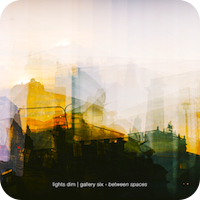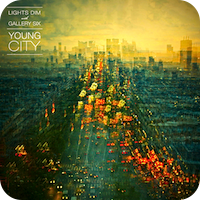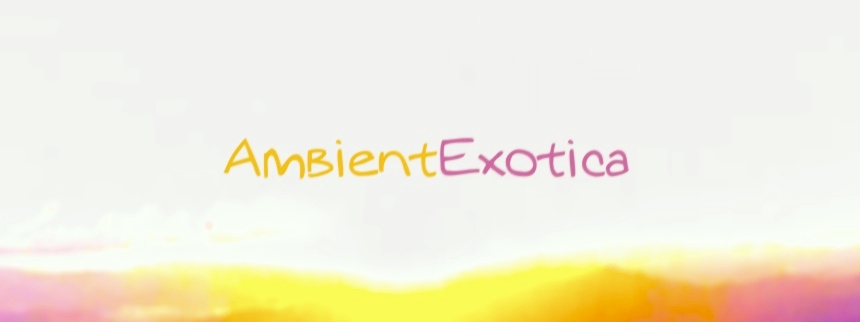
Lights Dim With Gallery Six
Between Spaces
2013
A retrospective after merely 14 months but worth any Drone aficionado’s while, Between Spaces is a ten-track album by the Polish-Japanese coalition of pianist, guitarist and synth wizard Marek Kamiński aka Lights Dim from Krakow, and the former drummer in Rock bands and recent Ambient luminary Hidekazu Imashige aka Gallery Six from Miyoshi near Hiroshima. It is released in September 2013 on the Japanese Nature Bliss label and can be ordered and fully streamed at Bandcamp. It comes in a physical edition limited to 300 copies cased in a retro 5,25" floppy disc which is inserted in a cardboard sleeve and further ennobled with the above artwork by Magnus Åström. Between Spaces unites two unique tracks that were specifically written for this album as well as the duo’s designedly emaciated yet glistening Moon EP from July 2012 – dedicated to the 43rd anniversary of the first manned moon landing – and the much more warmhearted and unexpectedly utopian Young City EP from May 2013. Both EP’s are presented in the way they were originally envisioned, with no further additions or mastering interferences. To be perfectly honest: calling Between Spaces an album would be ill-advised even though it does indeed meet the physical and quantitative demands of the format. However, it is nonetheless much more cohesive and well-balanced than many an Ambient album where an artist wants to feature a wealth of ideas. Here, however, the duo is mercilessly dedicated to the task at hand in order to craft the intrinsic qualities of the respective EP. Firmly situated in the Drone genre but, as the title Between Spaces implies, keen on venturing into the apexes, cusps and interstices of the layers, strata, patterns and surfaces, the ten tracks feature three different settings and moods which correlate with their boundaries and release cycles. It is best not to tell the greatest achievements and particular strengths of this quasi-album in advance, but to simply state right now that the atmosphere is king; if catchy melodies are needed, they are delivered, but not exclusively used. Field recordings and Glitch vestiges show their impetus as well. Here is a closer look at all tracks of Between Spaces, divided into their respective releases.
The album opens with two previously unreleased tracks, so fans of the duo who own the two EP’s receive a special treat right at the beginning, with the first offering being an eminently creepy example if one considers its ominous title which neglects the otherwise exclusively dreamy or poeticized scents of freedom. Be that as it may, the disc’s opener is called Echoes Of The Ongoing Riot, and while the listener is not thrown into a bellicose turmoil and thankfully only witnesses the titular echoes from a distance, the duality of this tune is remarkable: shuttling between spheroidal yearning and cinematic synthesizer chords, between Kamiński’s rufescent sunset guitar licks and lachrymose threnody, the result is a somnolent-easygoing Dream Pop hymn with soft classic drum kit percussion and an aerose-aeriform silkiness. The fleetingly mentioned cinematography derives from the simultaneity of all involved layers. Everything feels hued in reddish or orange colors, and even though the aura is somewhat glorifying, traces of nihilism and paralysis are baked into the mélange. The final 90 seconds comprise of a beatless structure and carve out the sylvan earthiness even more. Echoes Of The Ongoing Riot is an atypical piece for the duo, but an important one that lets Dream Pop permeate the Drone vaults. The second tidbit is called Dancing Beneath The Ocean, a thematically close and beatless appendix to the opener. The striking difference is the omission of any sign of danger. And yet the oceanscape feels heavy due to the sequences of adamantly melancholic and bass-coated guitar flumes on the one hand and piano-interspersed blissful overtones in major. Linking back to the album title, Marek Kamiński and Hidekazu Imashige build the arrangement in such a way that the afterglow of the tendrils and alluvial soils can float into yet another but entirely welcome sundown panorama. Both tracks work exquisitely well in tandem, are mutually dependent and gyrate between congruence and coherence.
with soft classic drum kit percussion and an aerose-aeriform silkiness. The fleetingly mentioned cinematography derives from the simultaneity of all involved layers. Everything feels hued in reddish or orange colors, and even though the aura is somewhat glorifying, traces of nihilism and paralysis are baked into the mélange. The final 90 seconds comprise of a beatless structure and carve out the sylvan earthiness even more. Echoes Of The Ongoing Riot is an atypical piece for the duo, but an important one that lets Dream Pop permeate the Drone vaults. The second tidbit is called Dancing Beneath The Ocean, a thematically close and beatless appendix to the opener. The striking difference is the omission of any sign of danger. And yet the oceanscape feels heavy due to the sequences of adamantly melancholic and bass-coated guitar flumes on the one hand and piano-interspersed blissful overtones in major. Linking back to the album title, Marek Kamiński and Hidekazu Imashige build the arrangement in such a way that the afterglow of the tendrils and alluvial soils can float into yet another but entirely welcome sundown panorama. Both tracks work exquisitely well in tandem, are mutually dependent and gyrate between congruence and coherence.
From the third track onwards, Between Spaces turns into a retrospective by featuring the duo’s previous two EP’s in the exact same way and right order they have been released heretofore. The Moon EP marks the debut of Lights Dim with Gallery Six and is traversed by multitudinous glitters and glints in front of a pitch-black pith of nothingness. Most of its four tracks present a trifecta that can be seen as the endemic golden thread: the star dust scintillae inherit a glitzy playfulness, the nonentity of the backdrop serves as a grave reminder of the hollowness, and last but not least, Marek Kamiński’s piano tones ameliorate the potentially ice-cold voidage with genteel bursts of benignancy. Long Distance Call launches with monotonous synth choir drones, glacial coils awash with polar lights, softened crackles and static noise particles as well a veil of soft tape hiss. Despite being a short vignette that is shy of two minutes, it sets the right tone and unleashes a humane warmth that is so terribly amiss out there. Sea Of Tranquility then sees the intertwinement of upfront piano tones, reverberated wooden clicks and prongs and the addition of polyhedron whistles plus beguiling wind chimes. Orbiting around nostalgia, enigma and cauterized fugacity, the whirling clings and plinking blebs cannot cover the concentrated gaze into the void. The titular tranquility is a heavy one whose warmth in shape of the piano is all too ephemeral and tangential. While Mission Time unchains another cavalcade of nocturnal cricket-evoking coppice sound fields, dripstone cave droplets plus portentous gongs and then moves into a forsaken yet glitz-studded antrum of high-plasticity vesicles without ever dropping one hummable scent of a melody, the EP’s finale Parachutes is draped in a crestfallen mournfulness and ends far too quickly for the sorrow to percolate mercilessly. The piano tones feel plaintive and wistful, the interstitial clefts empty and extirpated. Space is abhorrently empty after all.
coils awash with polar lights, softened crackles and static noise particles as well a veil of soft tape hiss. Despite being a short vignette that is shy of two minutes, it sets the right tone and unleashes a humane warmth that is so terribly amiss out there. Sea Of Tranquility then sees the intertwinement of upfront piano tones, reverberated wooden clicks and prongs and the addition of polyhedron whistles plus beguiling wind chimes. Orbiting around nostalgia, enigma and cauterized fugacity, the whirling clings and plinking blebs cannot cover the concentrated gaze into the void. The titular tranquility is a heavy one whose warmth in shape of the piano is all too ephemeral and tangential. While Mission Time unchains another cavalcade of nocturnal cricket-evoking coppice sound fields, dripstone cave droplets plus portentous gongs and then moves into a forsaken yet glitz-studded antrum of high-plasticity vesicles without ever dropping one hummable scent of a melody, the EP’s finale Parachutes is draped in a crestfallen mournfulness and ends far too quickly for the sorrow to percolate mercilessly. The piano tones feel plaintive and wistful, the interstitial clefts empty and extirpated. Space is abhorrently empty after all.
Young City EP is the final insular artifact of this album and is hands down my favorite work of Lights Dim with Gallery Six. Fans of crystalline and diffuse Drone washes will be delighted to encounter the duo’s wondrously blithesome and euphoric pieces. Society and cities are more often than not seen as a condemnable necessity of the current and futuristic lifestyle, a scourge for mankind, a dystopian pandemonium of squalor and hedonism. But not here, not in the four locations of the Young City EP, for this city is indeed juvenile, sylphlike and prismatic, with lush greeneries and verdured vestibules. After The End seems to carry apocalyptic notions, but these nebulous thoughts are annihilated via gorgeous field recordings of nearby rivers or fountains, chirping birds, frolicking children and – most importantly – luminescent synth ribbons which solemnly twirl in blazingly golden colors above the joyfully bustling city. Peacefulness and controlled paroxysms of flurry harmoniously unite in an idealistic aural diorama. A majestic piece which makes room for the night at its end when the nightbirds are heard in front of a starlit atmosphere of placidity. All Went Quiet comprises the same majestic peacefulness and features processed dream guitars in adjacency to short wind gusts, playful clicks and crackles and an almost vitreous cleanliness that cannot be actually heard, but is emanated by the polished textures and effulgent surfaces. We Could Finally Rest is a contravention of some sort, at least during its infancy stage when piano tones and guitar twangs create a laid-back, heavily reverberated moiré of sound, sustain and space. Deeply coated in contemplation, We Could Finally Rest slowly opens up by allowing louder – and more – tones in major to access the scenery. It cannot shake off its bucolic sadness entirely, but stresses the bittersweet state between the spaces. As the album title promises of which the EP is now a part of. The closer Voyagers is an electro-acoustic Drone riverbed of whitewashed tape hiss, prolonged guitar embellishments and an almost ecclesiastic organ-like gravity. New-Age-oid warped electric guitars fathom out the aerial room, distant and muffled traces of Penny Lane’s short film The Voyagers are interwoven, and the nearer the fade-out phase of this apotheosis is to the listener, the warmer and contented the ending feels.
golden colors above the joyfully bustling city. Peacefulness and controlled paroxysms of flurry harmoniously unite in an idealistic aural diorama. A majestic piece which makes room for the night at its end when the nightbirds are heard in front of a starlit atmosphere of placidity. All Went Quiet comprises the same majestic peacefulness and features processed dream guitars in adjacency to short wind gusts, playful clicks and crackles and an almost vitreous cleanliness that cannot be actually heard, but is emanated by the polished textures and effulgent surfaces. We Could Finally Rest is a contravention of some sort, at least during its infancy stage when piano tones and guitar twangs create a laid-back, heavily reverberated moiré of sound, sustain and space. Deeply coated in contemplation, We Could Finally Rest slowly opens up by allowing louder – and more – tones in major to access the scenery. It cannot shake off its bucolic sadness entirely, but stresses the bittersweet state between the spaces. As the album title promises of which the EP is now a part of. The closer Voyagers is an electro-acoustic Drone riverbed of whitewashed tape hiss, prolonged guitar embellishments and an almost ecclesiastic organ-like gravity. New-Age-oid warped electric guitars fathom out the aerial room, distant and muffled traces of Penny Lane’s short film The Voyagers are interwoven, and the nearer the fade-out phase of this apotheosis is to the listener, the warmer and contented the ending feels.
Two EP’s and two previously unreleased tracks form the elysian-enigmatic superstructure – or rather morphogenesis – of Between Spaces, a release that showcases two things the duo of Marek Kamiński and Hidekazu Imashige are capable of delivering terrifically well: firstly, whatever the mood of the respective first track may be, the artists make sure that it traverses the following tracks as well, with the desired interim result being a remarkable coherence. Instead of taking ideas which derive from areas few and far between, the taste, glow and structure are assembled, recomposed and compiled anew in a strictly organic way. Nothing feels forced or artificial, even in the coldest of moments, there is a human emotion, even if it only is the impression of feeling blue and sorrowful. The first two tracks form one unity, as do the two respective EP’s. Secondly, the duo is not only able to embrace stringency and maintain cohesion, but makes sure that the ideas sound splendid and fully fleshed out. The cinematography and bursts of rubicund colors in the two album-only tracks Echoes Of The Ongoing Riot and Dancing Beneath The Ocean create quasi-phantasmagoric sunsets which would not be out of place in an avantgarde indie video game or a multifaceted arthouse flick. Likewise, the abundance of crackles as found in and around the Moon EP has been heard thousands of times, sure, but these Glitch artifacts are not only used to create the impression of being near or on the moon, but to control the perceptual wideness of the aural locales. The many synth choirs remind of Zoë Blade’s Music From Mars (2011), but Lights Dim and Gallery Six are actually creating four piano arrangements whose state is covered by additional ingredients. The Young City EP finally is the most euphonious and effervescent artifact, with exceptionally crisp field recordings. Cogitation and deep thoughts become enmeshed in the shapes of yearning, nostalgic undertones, but this is nonetheless a utopian outlook to the things to come… and the final reason to look forward to Marek Kamiński’s and Hidekazu Imashige’s forthcoming projects.
Further listening and reading:
- You can purchase and listen to Between Spaces in full at Bandcamp.
- Follow Lights Dim with Gallery Six on Twitter: @Lights_Dim & @Gallery_Six.
Ambient Review 251: Lights Dim With Gallery Six – Between Spaces (2013). Originally published on Aug. 14, 2013 at AmbientExotica.com.
